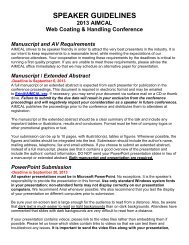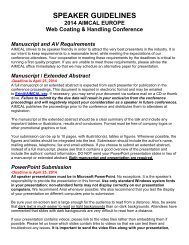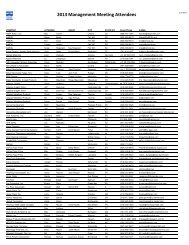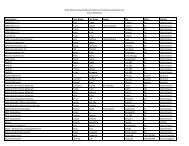Coating - Aimcal
Coating - Aimcal
Coating - Aimcal
You also want an ePaper? Increase the reach of your titles
YUMPU automatically turns print PDFs into web optimized ePapers that Google loves.
Executive Summaries • A Look Ahead<br />
extrusion Laminating<br />
& Film Making<br />
The basic extrusion laminating and coating technologies<br />
as we know them today began in earnest after the end<br />
of WWII and have continued to grow in capability and<br />
complexity in the years since. In the mid- to late-1980s,<br />
laminating capability for snack packaging with high bond<br />
strength was related to a basic capability of 100 mpm<br />
(330 fpm) speed with an 18-cm (7-in.) melt drop using<br />
LDPE at about 315 deg C (600 deg F). Today, you can<br />
purchase machines, which operate at high speed and<br />
material efficiencies while depositing multilayer coatings<br />
of five or more layers, if desired, to add improved barrier,<br />
optical or physical properties. The same improvements<br />
also are available for film manufacture ranging from cast,<br />
blown and oriented films for use with or to compete with<br />
the extrusion coater and extrusion laminator. In many<br />
cases, you are limited only by your imagination and<br />
pocketbook.<br />
The sources of the dramatic improvements in capability<br />
have been both evolutionary and revolutionary, and the<br />
knowledge gained about what makes a functional product<br />
is still controlling the final properties and attributes of the<br />
products made today. Primary areas of advancement<br />
have been in new resins, die design and coextrusion<br />
technologies, digital drives and the integration of multiple<br />
components and improved control methods. This has<br />
allowed existing product designs to be improved in both<br />
quality and productivity. At the same time, advances in<br />
basic machine components — such as screw designs<br />
and the extruder, die and coextrusion capabilities<br />
— all combine together to allow further productivity<br />
improvements and capabilities not possible from a single<br />
improvement.<br />
The availability of a widening range of new copolymers,<br />
tie resins, barrier and reinvented “old” resins has been<br />
driven by advances in polymerization research and<br />
catalyst technologies. These material advances have<br />
made the use of coextrusion widespread and extremely<br />
102 | 2012 AIMCAL SourceBook<br />
effective in product-property enhancements. Three-layer<br />
extrusion coatings and laminating layers using various<br />
copolymer-skin resins now allow the uncoupling of line<br />
speed and bond-strength development by reducing the<br />
impact of melt oxidation on bonding. Better and new<br />
surface-oxidation control of the melt is still possible in<br />
the future and is constantly being reinvented to improve<br />
bonding and, in combination with coextrusion, should<br />
allow further improvements in productivity down the road.<br />
The addition of barrier properties to the extrusion coating<br />
or laminating layer has kept pace with comparable<br />
advances in film extrusion. Five-layer barrier coatings<br />
and lamination layers are common, and nine- and higherlayer<br />
counts in packaging films readily are available<br />
from suppliers. new micro- or nano-layer coextrusion<br />
capabilities are now generally available and, combined<br />
with resin availability, will make significant and important<br />
improvements in film physical properties. The new<br />
coextrusion capabilities of splitting barrier-polymer layers<br />
permit further barrier improvements over single layers of<br />
the barrier polymers. Edge encapsulation (side-by-side<br />
coextrusion) also has improved scrap utilization and<br />
reduced neck-in for both film and extrusion coating.<br />
Continued growth and improvement in all of these areas<br />
should fuel further growth and advancements in product<br />
quality, performance and completion between film and<br />
lamination technologies and should extend these products<br />
into the new and evolving technologies we use in our<br />
everyday lives, from packaging and window films to solar<br />
cells and OLED TV screens. n<br />
By eldridge M. Mount, Ph.D., president, eMMount<br />
technologies, 585-223-3996, email: emmount@<br />
earthlink.net, www.emmount-technologies.com











